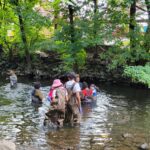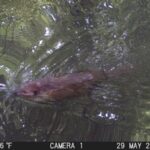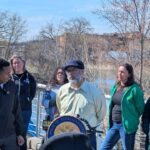Woodlawn Brook is a little known and easily overlooked tributary of the Bronx River, but it flows down through one of the most interesting and historic places in the Bronx River Valley.
Located on the ridge rising on the west side of the Bronx River, Woodlawn Cemetery provides a dramatic backdrop for much of the length of Shoelace Park. The crest of the ridge divides the Bronx River and Hudson River watersheds, and it is near this crest that Woodlawn Brook begins in a spring-fed lake.
Organized in 1863 on what had been mostly farmland, the Woodlawn Cemetery was intended to be New York City’s answer to Brooklyn’s fashionable Greenwood Cemetery, a place that Manhattanites (and their funerals) could easily reach via the New York & Harlem Railroad without a pesky ferry ride to Brooklyn.
Unlike the gloomy churchyards of yore, the Woodlawn Cemetery was designed according to the new concept of a “rural cemetery” in which tree-shaded pathways wound through landscaped grounds, inviting people to stroll and reflect. Far from considering it an inconvenience to be covered over, Woodlawn’s landscapers embraced the brook as a scenic element, and left it to babble unhindered down the hillside.
After a brief diversion under the train tracks, Woodlawn Brook emerged again to flow its last few yards into the Bronx River. The spot was scenic enough that a stereopticon card was sold that gave a 3-D view of the brook to armchair travelers.
This view can no longer be seen today. When in the early 1900s the city sliced away part of the hillside to extend Webster Avenue north of Gun Hill Road, Woodlawn Brook was channeled into a deep drain, and now joins the Bronx River from the end of a rather un-scenic outflow pipe.
Stephen Paul DeVillo




